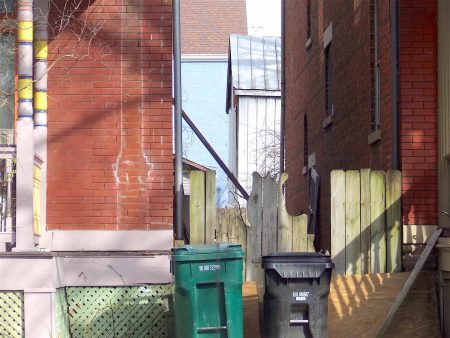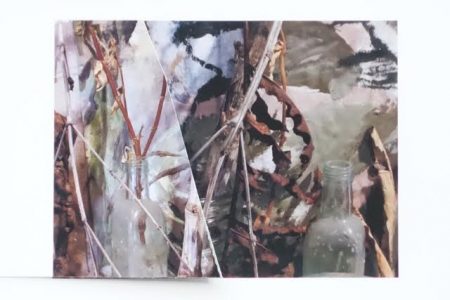When Harvey Osterhoudt and William Renschler worked together at the Indiana University Art Museum in the 1970s, they began a dialogue about photography that would inform their work for the next forty years. Through the early months of 2017, Over-the-Rhine’s Iris BookCafé featured the results of that conversation in Subject Matters, a two-man show of photographs focused on the dynamism of commonplace materials. Osterhoudt works in black-and-white and Renschler in color, each studying prosaic settings and everyday things while keeping the images free of people. Insisting on the substance of the inconsequential, they aim not toward the symbolic or sublime but instead evoke the affective potential of defamiliarized routine. Although the show excludes human figures it nevertheless accentuates embodiment, whether of inanimate objects or the viewers themselves.
In framing the encounter between bodies, Osterhoudt pays strict attention to “unpretentious stuff—trees, houses, fences—in unimportant places—a backyard, a street corner, a hillside—in short, nothing newsworthy or likely to attract tourists.” The resulting collection includes a range of juxtapositions: pliable surfaces with firm counterparts, thickets with spartan roadsides, dormant plants with evergreens, built environments with tangled, undomesticated spaces. Signs of human culture give way to rising forests; wooded tracts show signs of technological imposition. Despite his examination of mundane sites, the monochromatic palette casts an aura of nostalgia on the scenes, re-posing Walker Evans’s query as to “what any present time will look like as the past” (Thompson 151). There may be nothing “newsworthy” in Osterhoudt’s visuals, but his technique suggests reverence for the temporality of things.
One of his untitled portraits centers on a modest yard, cared for but unpopulated, bringing together the Americana of the picket fence with deceptively minor details—siding and corrugated brick, a main-floor awning and basement window, a shaded sidewalk. The outdoor setting feels closed-in as the walls limit our view of the world beyond. Like his images of roads cutting through woods, the sidewalk offers the possibility of exit but also deeper entry into the territory. While considering those prospects, the eye discerns a geometry of clean lines and loops, intersections and crosshatchings, right angles colliding with organic asymmetries. Rutted curvature opens onto glossy exteriors; charcoal coexists with shades of silver and cream. As a tree stretches toward its silhouette, there exists no hierarchy between hard things and the shadows they cast.
As Osterhoudt flattens conceptual privilege he addresses the observer as a kind of anti-tourist. Denying any cachet to the topic or style of his work, the artist statement associates shot perspective with the banality of the framed scenes: “The associative load of the subject matter and the vantage from which it is shown are equally ordinary. One might say, they fit.” Devoid of steep angles or misty filters, the photos invite a mode of perception that is as unobtrusive as its object. The match between standpoint and field of focus compels us to linger insofar as it refuses standard attributions of significance. Ordinary as the pictures are, they signal the vastness of possible response, defying swift or satisfying consumption. Clearly designated as “not for sale,” they frustrate the logic of the commodity.
That resistance to easy packaging parallels the pictures’ aversion to narrative, and thus to the articulation of a topic that unites the photographs. As Osterhoudt has it, “the photographs don’t in fact have a subject, only subject matter.” Each image accentuates the singularity of that subject matter, whether in the utilitarian dignity of a highway overpass or star-shaped drapery atop a telephone pole. We might be tempted to locate symbolic overtones in the latter image, though doing so privileges metaphor to matter, declining the show’s summons to engage the plain physicality of things. To accept that charge implies distrust not just of narrative but also of language itself, and more specifically, the appropriation of photography by words. Such appropriation inevitably distorts its referent by imposing meanings that, according to Osterhoudt, connote “the private realm of personal idiosyncrasies—those of the viewer(s) as well as of the photographer.” In his linguistic reflections on the exhibit, he ironically touts felt experiences that confound linguistic reflection; in denying subject matter the status of over-arching subject, his tribute to the non-narrative becomes a story in itself.
That story continues as viewers proceed deeper into the café and encounter the works of William Renschler. The range of colors expands, the frames become smaller and more crowded, and the tendency toward medium-distance shots gives way to close-ups. But the valuing of nondramatic materiality remains. As the storefront tightens into a hallway, we come upon a row of Renschler’s “Northside” photos, which include compact and sometimes partly occluded views of yards and gates, latticework and fences, garbage cans and curbstones. The atmosphere is autumnal, a core of earth tones splashed with crimson, teal, and the occasional bright yellow. Several of the images harbor arresting details—a cabinet lodged in porch railing, a flying bird-shadow cast against stucco—but the collection mostly avoids such touches, deriving gravity from the equivalence of parts within and across photographs. It conveys varied ideas of order, contrasting bars and grids with arcs and knotted boughs, valuing none more than the other.
No less partial to symbolism than is Osterhoudt, Renschler nevertheless admits the emblematic character of certain pictures, especially those that designate the ecological connectedness of objects. In a statement hidden in the rear of the shop, he speculates that “the more demanding and rewarding photographs represent, stand in for or are metaphors for […] the manner in which the world is all of a piece, how it locks together and resists being pulled apart.” A visualization of what Laurie Gries calls “new materialism,” the pictures revere the actuality and cohesion of the environment more than its translation into language, though the images are themselves a form of mediation and cannot lend unconditional access to the scenes they depict. They strive toward the affect of immediacy partly through the straightforward quality of those scenes, and partly by adopting what Ousterhoudt portrays as the unassuming vantage, a kind of studied informality.
In the Northside shots the vantages take in domestic exteriors and the small worlds they inhabit, everything locking into place. But as viewers move into the café’s back rooms they come upon Renschler’s more abstract and daring pieces, which add new layers—both literally and conceptually—to his vision of interconnected stuff. Picturing glassware and ceramic fragments, mossy branches and sanded wood, they present playful contrasts in texture and density, depth and tone. A bright, rubbery surface on one side of an image makes way for brittle shards on the other. As Renschler suggests, it all fastens together within a world that is “of a piece.” More distinctive, however, is the materiality of the photographs themselves, many of which bring together two or more previous images, slashed at oblique angles and recombined to fill out the picture plane. Some hide the splice so the photo looks at first like an otherworldly still life, whole and unaltered. Other splices are easier to spot as composite portions try with limited success to disengage from each other. The collection thus performs a range of bonds and mergers that are at once persistent and oddly tenuous.
Such tenuousness becomes especially notable in a piece where the edges of the joined pictures have started to separate and the photo-paper begins to dislodge from its backing. The detail implies that Renschler’s integrated world could well fly apart, or that its durability is less certain than he lets on. Another way to interpret the image, however, is to experience the loosened edge of the print as reaching out into the room, not tearing away from the domain of representation but establishing continuity with the world of the viewer. The materials of Renschler’s corpus thus lock together with the haptic dimensions of the exhibition space, its eclectic surfaces and worn books, along with the embodiment of its patrons. As a sliver of picture extends toward us, its self-assertion and metaphorical resonance become productively confused.
Amid that confusion the linkage between Renschler’s and Osterhoudt’s work attains clarity, as does the value of long-term collaborative thinking. Both artists tell stories while claiming non-narrative motivations, dwelling on “unimportant places” with affection and irony; both concentrate on the surfaces of things while paradoxically generating an affect of thickness. We note differences in style as we wander through the exhibit, but the harmonies make the stronger impression; the show locks together in a way “that resists being pulled apart.” But it also spotlights the contingency of such assessments—the meeting of the artists’ idiosyncrasies with our own. The show presses us to consider the physicality of that merger, and to inhabit the fit between vantage and subject matter with reflective diligence. In that way a conversation that began in Bloomington forty years ago expresses its own continuing materiality, attesting to the unpredictable expanse through which seemingly local things move.
–Christopher Carter is an associate professor and Composition Director in the English Department at the University of Cincinnati. He is the author of Rhetoric and Resistance in the Corporate Academy (Hampton Press, 2008) and Rhetorical Exposures: Confrontation and Contradiction in US Social Documentary Photography (University of Alabama Press, 2015).


